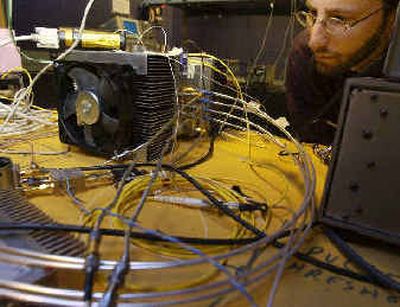Quantum leap in security

CAMBRIDGE, Mass. — It’s a hacker’s nightmare but a dream for bankers and spies: A computer network so secure that even the simplest attempts to eavesdrop will interrupt the flow of data and alert administrators to the snooping.
The work by researchers at Harvard University, Boston University and BBN Technologies is the closest scientists have come to a real-world quantum encryption system that uses light particles called photons to lock and unlock information instead of random-number “keys.”
Using the technology, the scientists can swap data, send e-mail and visit one another’s Web sites as their data is protected.
Researchers are still exploring its practical applications, but some say it could one day replace the encryption now used for most secure Internet traffic, and shield financial or government communications.
“It is really a futuristic technology,” said Harvard project scientist John M. Myers. “Its applications are going to be a lot like the laser and the transistor, in that early people could not think of all the possible applications and uses of it.”
Quantum cryptography depends on a defining discovery in physics: that subatomic particles can exist in multiple states at once until something interacts with them. Thus, even observing photons used in quantum encryption changes them, ruining the codes.
The project, funded with about $4 million from the Pentagon’s Defense Advanced Research Projects Agency, is far from alone in developing quantum cryptography. A New York-based company, MagiQ Technologies, has begun selling units for commercial use while a group in Europe recently made the first quantum encrypted bank transaction.
But the Boston network — though limited to the three locations — is believed to be first Internet-integrated system that runs continuously between multiple distant locations.
BBN, the company that created the Internet predecessor called ARPANET, has been sending quantum keys for two years. Harvard was linked to the BBN network in May, and Boston University in June.
Quantum encryption has its roots in the “one-time pad” system used by spies in World War II. These were identical pads of random numbers, each page a different key for encoding and decoding messages. A code could be unscrambled only if the recipient had the same page as the sender.
On the quantum network, a laser separates individual photons, and sends them to a device called a modulator. The modulator pumps them out to other network nodes on fiber optic cable. The photons are encoded by sending them out at different intervals: a long gap indicates one bit of information, and a shorter one a different bit.
On the receiving end, another device accepts the photons and recognizes how they’re modulated. If the sequence matches what was originally sent, then the keys are stored and used to unscramble data sent through conventional means between the different network nodes, such as over the Internet.
Eavesdropping on the photons, such as setting up a photo detector to read the code, disrupts them, making the codes unusable and alerting the network to the snooper.
Theoretically, quantum computers could one day become as common as desktops are today.
And BBN chief scientist Chip Elliott said there’s no technical barrier to the widespread use of quantum cryptography.
For him, it’s a question of when, not if.
“This is what every teenager wants: Instant messaging protected by quantum cryptography,” he said. “Don’t tell my daughter.”